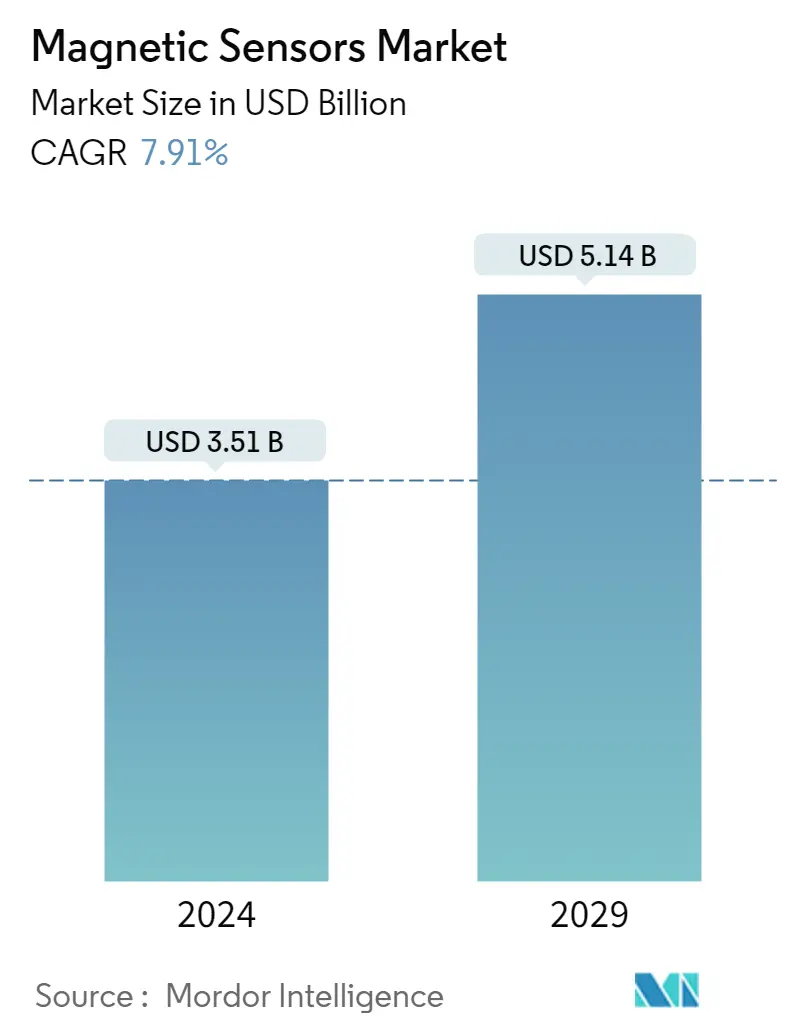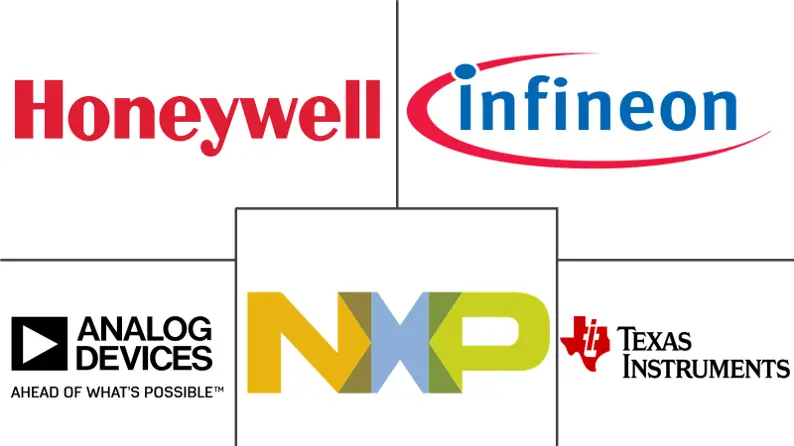Market Size of Magnetic Sensors Industry

| Study Period | 2019 - 2029 |
| Market Size (2024) | USD 3.51 Billion |
| Market Size (2029) | USD 5.14 Billion |
| CAGR (2024 - 2029) | 7.91 % |
| Fastest Growing Market | Asia Pacific |
| Largest Market | Asia Pacific |
Major Players
*Disclaimer: Major Players sorted in no particular order |
Magnetic Sensor Market Analysis
The Magnetic Sensors Market size is estimated at USD 3.51 billion in 2024, and is expected to reach USD 5.14 billion by 2029, growing at a CAGR of 7.91% during the forecast period (2024-2029).
The high usage of magnetic sensors in new navigation devices, presence detection (building automation-related applications), medical areas, and the automotive sector are leading to a paradigm shift in the magnetic sensors market around the world.
- The increase in demand for IIoT and the production of consumer electronics, electric and hybrid vehicles, and high-quality sensing devices, globally, are influencing the adoption of magnetic sensors across several end-user industries. This is expected to drive the growth of magnetic sensors during the forecast period.
- An increase in the adoption of robotics for factory automation, owing to the Industry 4.0 policies, is driving the need for magnetic sensors for various safety applications in the global market. The development in the services sector in the country and high growth rate of data center and cloud providers are further augmenting the demand for these sensors to be deployed in the power distribution unit (PDU), which forms a crucial part in data centers.
- However, the recent outbreak of COVID-19 is influencing both the demand and production of the semiconductor industry. Asia-Pacific holds the major share in the semiconductor and electronics industry, as countries, such as China, Taiwan, and South Korea, are home to a significant number of pureplay foundries in the world.
Magnetic Sensor Industry Segmentation
Magnetic sensors are classified in terms of measuring a complete magnetic field or vector-components of the magnetic field. Permanent magnets, such as neodymium magnets, are used to trigger the magnetic sensors in several applications. The magnetic sensor is used to identify the magnitude and direction of the magnetic field. It includes a rotating sensor tip, which measures both transverse and longitudinal magnetic fields around the objects.
| Technology | |
| Hall Effect | |
| Anisotropic Magneto Resistance (AMR) | |
| Giant Magneto Resistance (GMR) | |
| Tunneling Magneto Resistance (TMR) | |
| Other Technologies |
| Application | |
| Automotive | |
| Consumer Electronics | |
| Industrial (Excluding Automotive) | |
| Other Applications |
| Geography | ||||||
| ||||||
| ||||||
| ||||||
|
Magnetic Sensors Market Size Summary
The magnetic sensor market is experiencing significant growth, driven by its increasing application in various sectors such as navigation devices, building automation, medical fields, and the automotive industry. The demand for industrial IoT, consumer electronics, and electric vehicles is propelling the adoption of magnetic sensors across multiple end-user industries. The shift towards robotics and factory automation, influenced by Industry 4.0 policies, is further boosting the need for these sensors, particularly for safety applications. Additionally, the expansion of data centers and cloud services is augmenting the demand for magnetic sensors in power distribution units. However, the semiconductor industry's production and demand have been impacted by the COVID-19 pandemic, with Asia-Pacific regions like China, Taiwan, and South Korea playing a crucial role due to their substantial semiconductor and electronics industries.
In the automotive sector, magnetic sensors are increasingly utilized to enhance vehicle convenience and fuel efficiency, with government regulations mandating their use in safety equipment. The market is witnessing a rise in the deployment of GMR and TMR sensors due to their low power consumption and compact size, making them suitable for various automotive applications. The proliferation of electric and hybrid vehicles, along with the integration of GPS technology, is expected to further drive the demand for magnetic sensors. In regions like China and Japan, the automotive and consumer electronics industries are significant contributors to the market, with magnetic sensors being essential for applications such as anti-braking systems and industrial robots. The competitive landscape of the magnetic sensor market is characterized by technological advancements, with companies like AKM, Infineon Technologies, and Honeywell focusing on integrating advanced technologies to enhance their product offerings.
Magnetic Sensors Market Size - Table of Contents
-
1. MARKET DYNAMICS
-
1.1 Market Overview
-
1.2 Industry Attractiveness - Porter's Five Forces Analysis
-
1.2.1 Threat of New Entrants
-
1.2.2 Bargaining Power of Buyers/Consumers
-
1.2.3 Bargaining Power of Suppliers
-
1.2.4 Threat of Substitute Products
-
1.2.5 Intensity of Competitive Rivalry
-
-
1.3 Market Drivers
-
1.3.1 Increasing Regulations Around Energy-efficient Systems and Automobiles
-
1.3.2 Emerging Applications in Consumer Electronics and Data Centers
-
-
1.4 Market Restraints
-
1.4.1 Falling Average Selling Prices (ASPS) of Semiconductors and Sensors
-
1.4.2 Coronavirus Outbreak Influencing the Electronics Industry
-
1.4.2.1 Assessment of COVID-19 Impact on the Industry
-
-
-
-
2. MARKET SEGMENTATION
-
2.1 Technology
-
2.1.1 Hall Effect
-
2.1.2 Anisotropic Magneto Resistance (AMR)
-
2.1.3 Giant Magneto Resistance (GMR)
-
2.1.4 Tunneling Magneto Resistance (TMR)
-
2.1.5 Other Technologies
-
-
2.2 Application
-
2.2.1 Automotive
-
2.2.2 Consumer Electronics
-
2.2.3 Industrial (Excluding Automotive)
-
2.2.4 Other Applications
-
-
2.3 Geography
-
2.3.1 North America
-
2.3.1.1 United States
-
2.3.1.2 Canada
-
-
2.3.2 Europe
-
2.3.2.1 United Kingdom
-
2.3.2.2 Germany
-
2.3.2.3 France
-
2.3.2.4 Rest of Europe
-
-
2.3.3 Asia-Pacific
-
2.3.3.1 China
-
2.3.3.2 Japan
-
2.3.3.3 India
-
2.3.3.4 Rest of Asia-Pacific
-
-
2.3.4 Rest of the World
-
2.3.4.1 Latin America
-
2.3.4.2 Middle East & Africa
-
-
-
Magnetic Sensors Market Size FAQs
How big is the Magnetic Sensors Market?
The Magnetic Sensors Market size is expected to reach USD 3.51 billion in 2024 and grow at a CAGR of 7.91% to reach USD 5.14 billion by 2029.
What is the current Magnetic Sensors Market size?
In 2024, the Magnetic Sensors Market size is expected to reach USD 3.51 billion.

